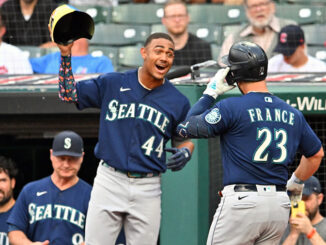
Let’s begin by saying this: I possess a deep love of baseball, but of all the 70,000 (and rapidly rising) reasons why I wish the coronavirus pandemic didn’t exist, being able to watch an MLB game feels trivial.
However, everyone’s state of suffering through this crisis is different and relative to their own experience. So, while I don’t want to equate the suffering people all over the world have gone through, are going through, and will go through to me missing baseball, because that would be ridiculous, my sadness about no baseball is genuine and worthy of acknowledgement in this context.
Therefore, this article will address a proposed 2020 MLB realignment and fully ignore the reality that all sports, while deeply meaningful to many, aren’t remotely important in the face of a global pandemic.
Okay, so what’s this 2020 realignment chatter all about?
There have been (I assume) several conversations behind Major League Baseball’s closed doors about just what can, or—maybe more importantly—can’t, be done to safely play baseball in 2020. In the face of a pandemic, I can only imagine what kinds of “outside the box” thinking has been offered, but one plan has surfaced or leaked that seems to concentrate on minimizing team travel by focusing on geography.
Presuming COVID-19 testing would be readily available, this plan would eliminate the need to isolate players and allow them play at their home ballparks… Though, without any fans in the stadium seats.
Under this scenario, the traditional “National” and “American” leagues would be suspended for the year, while all 30 teams play a shortened season (around 100 games) split into three regional divisions: East, Central, & West.
This is the proposed divisional realignment structure:
EASTERN DIVISION
The New York Yankees, New York Mets, Boston Red Sox, Washington Nationals, Baltimore Orioles, Philadelphia Phillies, Pittsburgh Pirates, Toronto Blue Jays, Tampa Bay Rays, and Miami Marlins.
CENTRAL DIVISION
The Chicago Cubs, Chicago White Sox, Milwaukee Brewers, St. Louis Cardinals, Kansas City Royals, Cincinnati Reds, Cleveland Indians, Minnesota Twins, Atlanta Braves, and Detroit Tigers.
WESTERN DIVISION
The Los Angeles Dodgers, Los Angeles Angels, San Francisco Giants, Oakland Athletics, San Diego Padres, Arizona Diamondbacks, Colorado Rockies, Texas Rangers, Houston Astros, and our beloved Seattle Mariners.
***
Under the proposed plan, each team would play its entire 100-ish-game season against the same nine other teams in the regional divisions before an unclear playoff arrangement. There are several compelling benefits this new team realignment would bring to bear on the MLB.
One upside of these projected groupings is that many of the most storied rivalries would still be intact, if not elevated under the compact scheduling. Classic foes like the Yankees-Red Sox, Cubs-Cardinals, or Dodgers-Giants would still have plenty of chances to get one over on their most disliked franchises.
Another positive would be the increased consequences of cross-town games. While games between same-city teams such as the Yankees-Mets, Cubs-White Sox, or Dodgers-Angels are always fun for the locals, they rarely have an impact on the playoffs because both teams usually played in different leagues. On this plan, they would be competing directly for the same postseason spots and watching cross-town fanbases invest in the competition would be all kinds of fun.
One additional advantage of the proposal would be the temporary elimination of the Designated Hitter argument. As far as we’ve heard, the plan would make the DH a universal position for all teams during the shortened season. And while some teams or fans might balk (!) at the idea of conceding the decades-old debate, it would be invaluable for top MLB decision makers to see a universal DH in practical application. They could then make decisions about the future of baseball as it pertains to the DH position with actual data and experience, rather than just the hypothetical scenarios people have been discussing for almost 50 years.
All possible advantages aside, there is a low-level challenge that needs to be mentioned.
The idea of having three divisions, each with 10 teams, has a clean, balanced look to it, but there’s an inherent unfairness there too. In practice, the teams from the Western Division would have to endure appreciably greater travel distances that include multiple time zones than those in the Eastern or Central Divisions.
Personally, I don’t think it’s as big of a deal as some. These teams are used to flying thousands of miles during a regular MLB season, so while there may be an imbalance between the three divisions, the actual distances traveled by the teams most affected would be far less than “normal.”
For example, look at our treasured Seattle Mariners. The M’s travelled more than any other MLB team in 2016 and 2019, edging out other contenders like the Oakland Athletics and Los Angeles Angels. It’s no surprise that the top travelling teams would come from the AL West, given that two of their frequent in-division destinations are in Texas, halfway across the country.
I fully understand the disadvantage that travel is, but these teams are used to it and I don’t think they would let it affect their performance as much as some less-travelled teams might. Also, these guys have got to appreciate the airline miles!
So, will this proposed divisional realignment happen in 2020? Officials from within the MLB offices have been unwilling to comment publicly, as the plan hasn’t been finalized or announced, but a few have had positive things to say anonymously. Things like “It’s all coming together’’ or “I’m very optimistic.”
Other insiders have provided a more pragmatic take on the situation. “This is going to be a season,’’ one executive said, “like we’ve never seen. But that’s fine. It’s at least a season.”
And personally, that’s where I land on the proposal as well.
The games wouldn’t be open to the public and the divisions wouldn’t be normal, but it would be baseball. Real, actual, genuine baseball played by professionals at the highest levels with strikeouts and home runs and everything. And good golly, is that something we all need right now.
Baseball isn’t a vaccine for the Coronavirus, but it would be a pleasant antidote to being quarantined and wishing things could get back to normal. Or, some kind of a new, realigned normal at least.




